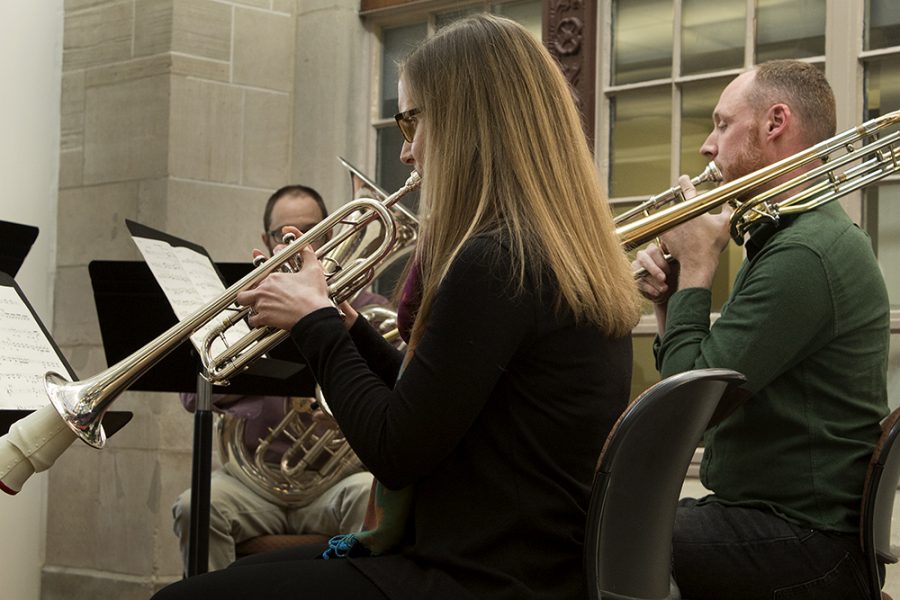Music reflects astronomers’ contributions
Jenny Brown, a trumpet instuctor, and Will Porter, a trombone instructor, perform one of the five movements from “Celestial Suite” Wednesday afternoon at Booth Library. The five movements each highlight an astronomer or physicist.
March 27, 2019
Eastern’s brass quintet blasted the audience away with “Celestial Suite,” a piece featuring five individual movements, in conjunction with Booth Library’s exhibit “On the Shoulders of Giants: The Moon and Beyond.”
There were five movements in the piece composed by James Stephenson; each movement featured a soloist while the rest of the quintet accompanied.
The “Celestial Suite” reflected connections between astronomy and sacred music. The five instruments were dedicated to famous astronomers and physicists.
Each piece was played in a major or minor key, and each individual key contributed to the entire spelling of the word “Earth” itself. For example, “E major” was “E” in “Earth,” while “A major” was the letter “A” in “Earth,” according to the Stephenson Music website.
The piece started off with Jenny Brown on trumpet. This piece was focused on Nicolaus Copernicus, an astronomer who created the heliocentric model that illustrated the fact that the sun was the center of the universe instead of the Earth.
The trumpet played in the key of G, which can be referred to “sol,” which means “sun” in Latin, Brown said.
The second movement was dedicated to Galileo and led by French horn player Jessica Pearce.
The movement was about how Galileo supported Copernicus’ theory on heliocentriusm, but Galileo faced a great deal of scrutiny from the church for believing in it, Pearce said.
During this time, Galileo’s friend Maffeo Baberini became Pope Urban VIII. He was supportive of Galileo’s findings sometimes, but other times he disagreed with Galileo for political reasons, she said.
Pearce jokingly introduced the next piece by making sure the audience understood the performance was dedicated to the astronomer Galileo, not the “Bohemian Rhapsody” Galileo. Evan Kelsick followed Galileo’s movement with a movement dedicated to Newton, which he performed playing the tuba.
The piece is focused on Newton’s first and third law. Newton’s first law theorizes that an object stays at rest until an outside force acts upon it; his third law theorizes that every action has an opposite or equal reaction.
This piece is about how the player cannot change notes until someone else does, representing to Newton’s first law.
Trombonist Will Porter led Edward Hubble’s movement.
Hubble made the discovery that there are galaxies beyond the Milky Way, he said.
“In 1924, (he discovered other galaxies) using the hooker telescope in Mount Wilson in California, which was then the world’s largest telescope,” Porter said.
Hubble also helped to shape the Big Bang Theory, he said.
The score of the movement was also formatted into the shape of a telescope, Porter said.
Lastly, the guest artist Keven Lewis played on the flugelhorn for the last movement, which was dedicated to Steven Hawking.
The last movement focused on the debilitating disease Hawking had, Lou Gehrig’s disease (ALS), and how even though it impaired him physically, he was still able continue his research, Lewis said.
Melissa Jabek can be reached at 581-2812 or at majabeck@eiu.edu.





































































